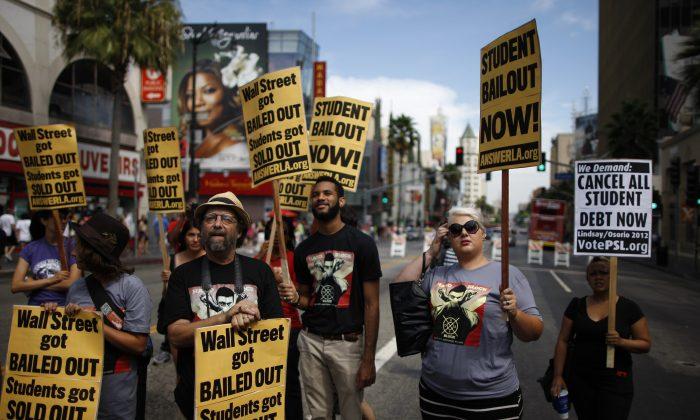Americans with a college degree traditionally have a better chance at landing a well-paying job than those without. However, due to the 2007–2008 financial crisis and subsequent economic upheaval, many American parents may no longer have the resources to send their kids to college.
According to the New York Fed, it is still worthwhile though. “College graduates have lower unemployment rates, fare better during recessions, and enjoy wages roughly double those of high school graduates,” it states in an article.
Given the lack of parental financial support, many students resort to debt to fund their education. The number of student loans soared since the first quarter of 2005, from 23.3 million to 38.8 million at the end of the fourth quarter of 2012, a 40 percent increase, according to the New York Fed.
With the increase in numbers came a staggering increase in volume. The Consumer Financial Protection Bureau (CFPB) estimated that student loan debt had reached $1.2 trillion by May 2013.
According to the CFPB, “Student loans now comprise the second largest form of consumer debt behind home mortgages.”
The problem: With their degree in hand and loaded with debt, many former students haven’t landed a proper job. Despite the improvement in the labor market, the unemployment rate, including underemployment, still stands at 14 percent.
If the student doesn’t get a job and start repaying at the scheduled rate, consequences could be dire. Since student loans are “non-recourse,” that is, they cannot be handed back like the keys for a house or a car, future wages of debtors could be appropriated.
According to the CFPB, 6.5 million or 17 percent of former students have defaulted on their loans already. Another 3.4 million or 9 percent of former students are behind in their loan payments.
The CFPB states, “If borrowers were aware of and able to easily enroll in income-based plans through their servicer, many federal student loan defaults could have been avoided.”
In April, a new federal student loan repayment plan, Pay As You Earn, was rolled out. Repayment is limited to 10 percent of income above the poverty line.
Another program is Income-Based Repayment which limits payments to 15 percent of discretionary income. Discretionary income is the amount left over after all essentials are deducted.
Obama’s Take Given
President Barack Obama has come up with ideas that make college more affordable. He thinks tuition has been a major cause for student borrowing needs.
“Over the last three decades, the cost of higher education has gone up 260 percent, at a time when family incomes have gone up about 18 percent,” remarked Obama, during a recent speech at New York’s Binghamton University.
Obama also wants to cap the loan repayment at 10 percent of monthly income.
According to the American Enterprise Institute, however, the 10 percent cap is a bad idea. This proposal would allow millions of students to repay only a portion of their debt. It would also increase the incentive for students to enroll in programs for interest’s sake only.
In addition, the article states that the federal government is the source of the problem. The government hands out student loans, and colleges increase tuition fees, knowing students can pay for higher fees with government loans.
In turn, the government increases loan availability for students facing higher tuition, without trying to keep tuition raises in check.
Rates Stay Low
Academics and economists discussed and dissected Obama’s proposal without coming up with how it would eliminate the need to take out federal subsidized loans.
However, one problem was resolved: The interest rate on loans that doubled on July 1 due to inaction by Congress was resolved. A bipartisan bill became public law on August 9. It retroactively lowered the loan rate from 6.8 percent to 3.6 percent and another loan rate to 4.6 percent. However, the rate could go as high as 9.5 percent and 10.5 percent respectively in the future.
Although the bill lowered the cost of student loans temporarily, it does not resolve the problem of the ever increasing need for student loans. Without an improvement in the unemployment situation and a decrease in the high cost of college tuition, the need for student loans will continue and with it the student debt.




